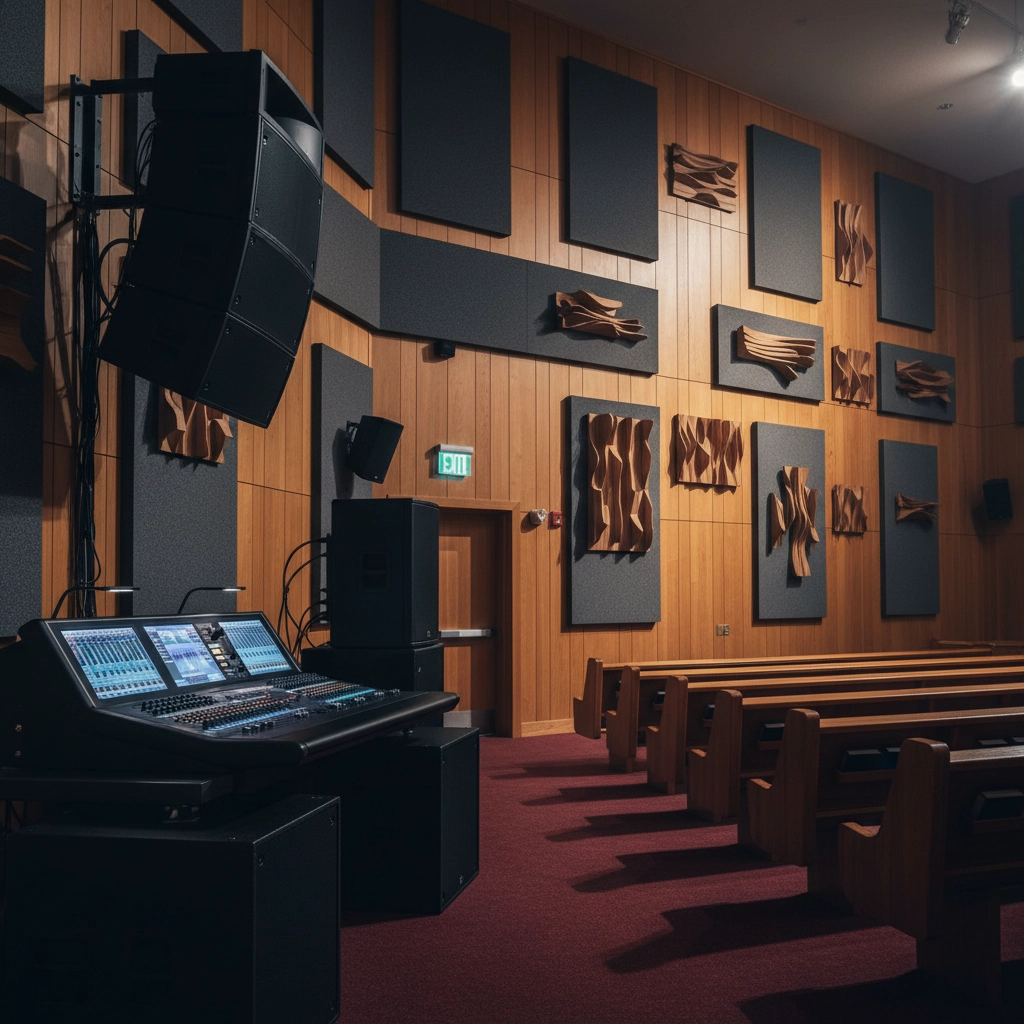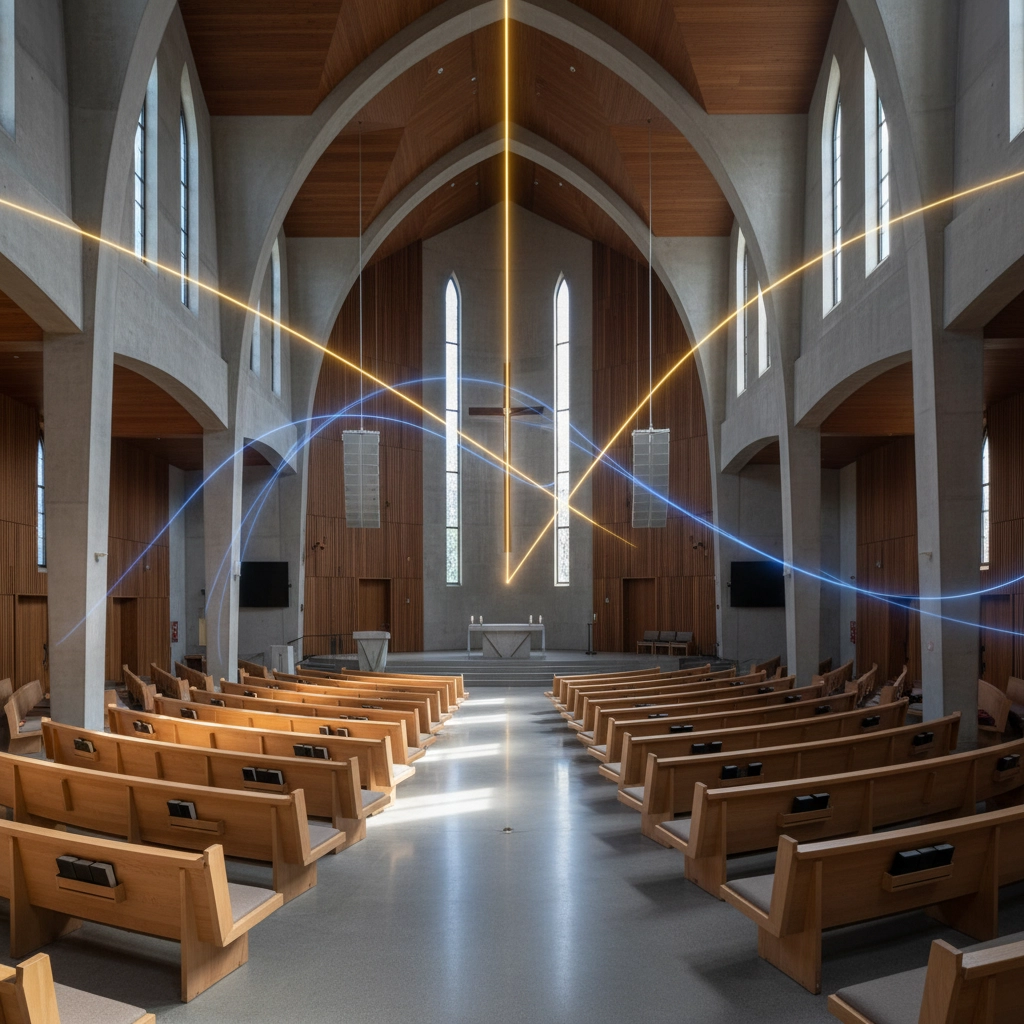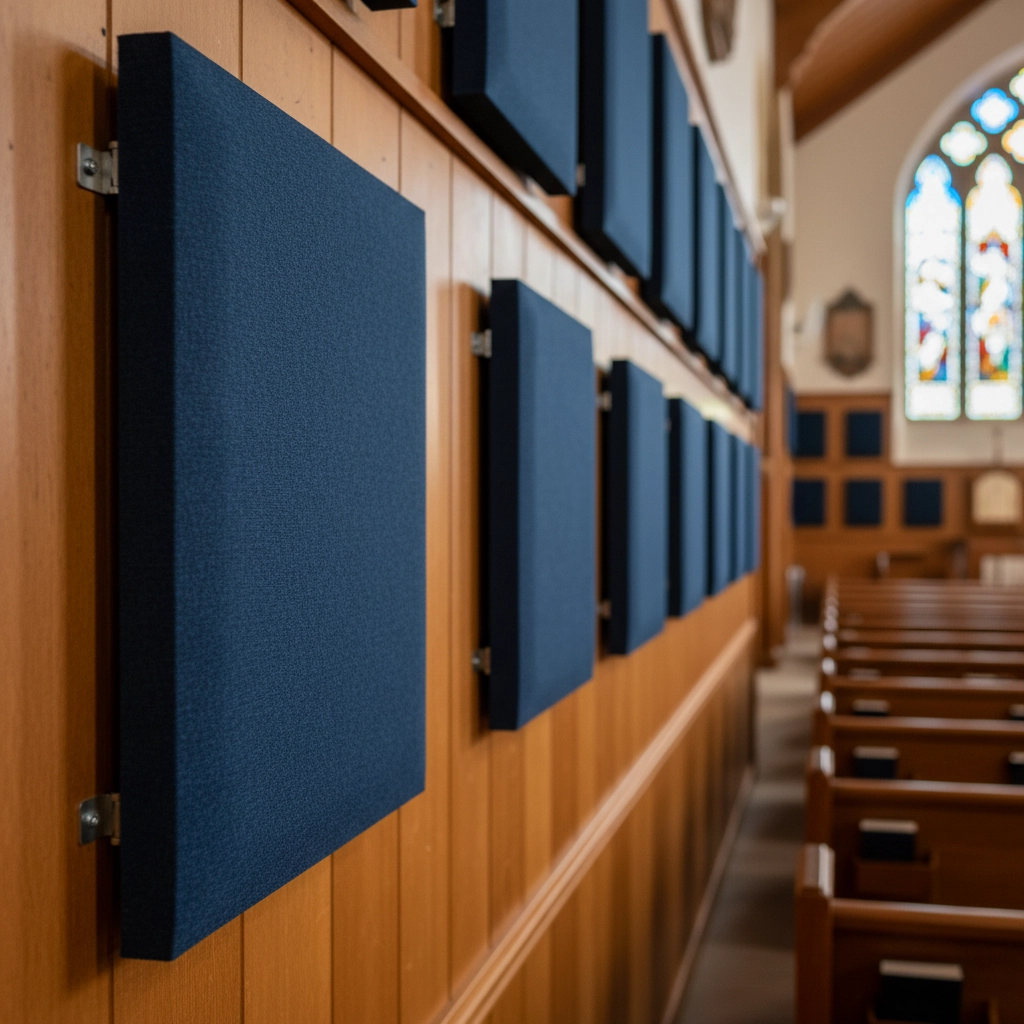Audio Quality vs. Room Acoustics: Which Matters More for Your Space?
- davidau
- Oct 20
- 5 min read
When planning your sanctuary's sound system, you're faced with a classic dilemma: Should you invest in premium speakers and audio equipment, or focus on improving your room's acoustics? It's a question that keeps many church leaders up at night, especially when working with limited budgets.
The answer might surprise you. While both elements are crucial, room acoustics typically have a far greater impact on what your congregation actually hears than the price tag on your equipment.
The Foundation: Understanding Audio Quality vs. Room Acoustics
Audio quality refers to the technical performance of your equipment: speakers, amplifiers, microphones, and mixing consoles. High-end gear offers superior frequency response, lower distortion, and enhanced dynamic range. These components are the tools that create and reproduce sound.
Room acoustics, on the other hand, determine how that sound behaves once it leaves your speakers. This includes how sound waves bounce off walls, floors, and ceilings, how they interact with furniture and people, and how they ultimately reach your congregation's ears.
Think of it this way: if your audio equipment is the paintbrush, your room's acoustics are the canvas. Even the finest brush can't create a masterpiece on a poor canvas.

Why Room Acoustics Often Take the Lead
Here's the reality that many discover too late: a well-treated room can make modest equipment sound exceptional, while poor acoustics can make even the most expensive speakers sound muddy and unclear.
In most church spaces, sound waves travel from your speakers and immediately begin interacting with hard surfaces like walls, floors, and ceilings. Without proper acoustic treatment, these reflections create a confusing mix of direct and reflected sound that reaches your congregation at slightly different times, causing echoes, standing waves, and frequency buildup.
The Size Factor Smaller sanctuaries often struggle with "boxy" sound due to quick reflections off nearby surfaces. Larger spaces may battle echoes and uneven bass distribution. Each room size presents unique acoustic challenges that no amount of expensive equipment can overcome alone.
The Clarity Connection When reflections and standing waves are controlled through proper acoustic treatment, you'll notice immediate improvements in vocal intelligibility and musical clarity. Suddenly, that mid-range speaker system sounds like it received a major upgrade: without changing a single component.
Real-World Church Scenarios
Let's look at three common situations many faith communities face:
Scenario 1: The Historic Sanctuary Your beautiful, traditional space features high ceilings, hard plaster walls, and wooden pews. The architecture creates natural reverence but also significant acoustic challenges. Installing the latest line array system won't solve the fundamental issue of excessive reverberation time. However, strategic placement of acoustic panels and sound-absorbing materials can transform the listening experience while preserving the space's aesthetic integrity.
Scenario 2: The Multi-Purpose Room Many growing churches start in fellowship halls or rented spaces with concrete floors, drywall surfaces, and metal ceilings. These rooms are acoustic nightmares, but they're also incredible opportunities. With modest acoustic treatment: portable panels, ceiling clouds, and strategic carpet placement: you can create surprisingly good sound quality with basic equipment.
Scenario 3: The Modern Build New construction offers the best of both worlds: the opportunity to design proper acoustics from the ground up while installing quality equipment. Churches that prioritize acoustic design during construction often find they need less expensive equipment to achieve their desired sound quality.

Evaluating Your Current Space
Before making any equipment purchases, take an honest assessment of your room's acoustic properties:
The Clap Test Stand in different areas of your sanctuary and clap your hands sharply. Listen for echoes, reverb tail, or "slap back" from hard surfaces. If you hear distinct echoes or a "flutter echo" (rapid repetitions), your room needs acoustic treatment.
The Speech Test Have someone speak from your pulpit while you listen from various seating positions. Can you clearly understand every word? If consonants sound mushy or words blend together, poor acoustics are likely the culprit.
The Music Test Play familiar recorded music through your current system. Does it sound muddy or unclear compared to listening through quality headphones? This often indicates acoustic issues rather than equipment limitations.
The Cost-Effectiveness Factor
One of acoustic treatment's biggest advantages is cost-effectiveness. Strategic placement of acoustic panels, bass traps, and diffusers typically costs a fraction of high-end audio equipment while delivering more noticeable improvements.
Consider this example: A $15,000 speaker upgrade might provide a 20% improvement in technical performance, but if your room has poor acoustics, your congregation might only perceive a 5% improvement. However, $5,000 in strategic acoustic treatment might deliver a 50% improvement in perceived sound quality.

Practical Acoustic Solutions for Churches
Absorption Solutions Acoustic panels on side walls and the rear wall help control early reflections that can muddy your sound. These panels can be designed to match your décor or even incorporate meaningful artwork or imagery.
Diffusion Elements Rather than simply absorbing sound, diffusion elements scatter sound waves to create a more natural acoustic environment. This is particularly effective for maintaining some of the "live" feeling that enhances worship music while controlling problematic reflections.
Bass Management Low-frequency sound waves require special attention. Corner bass traps and strategic panel placement can even out bass response throughout your sanctuary, ensuring consistent sound quality in every seat.
Ceiling Treatment Suspended acoustic clouds or panels can dramatically reduce ceiling reflections while maintaining the visual openness of your space. This solution works particularly well in rooms with hard, reflective ceiling materials.
Finding the Right Balance
This isn't to say equipment quality doesn't matter: it absolutely does. The ideal approach combines thoughtful acoustic treatment with appropriate equipment selection. Here's how to prioritize your investments:
Phase 1: Address Major Acoustic Issues Start with the most problematic acoustic elements in your space. This might mean adding absorption to control excessive reverberation or installing bass traps to even out low-frequency response.
Phase 2: Optimize Equipment Placement With improved acoustics, you can often achieve better results by repositioning existing equipment rather than replacing it. Speaker placement becomes much more critical and effective in a well-treated room.
Phase 3: Strategic Equipment Upgrades Now that your room can showcase equipment improvements, invest in components that will make the most difference. Often, this means upgrading your mixing console or adding processing equipment rather than immediately jumping to premium speakers.
For more insights on improving your sound quality, consider how acoustic treatment and equipment work together to create exceptional worship experiences.
Making the Decision for Your Space
The question isn't really whether audio quality or room acoustics matter more: it's understanding that they work together, with acoustics providing the foundation that allows equipment to perform at its best.
If you're working with a limited budget, prioritize acoustic improvements first. Your congregation will notice clearer vocals, better musical balance, and improved overall sound quality immediately. As your budget allows, you can then invest in equipment upgrades that will truly shine in your acoustically optimized space.
Remember, the goal isn't to create a recording studio: it's to create an environment where your congregation can fully engage with worship without acoustic distractions. Sometimes the most meaningful upgrade isn't the most expensive equipment; it's the treatment that allows your message to be heard clearly in every seat.
The most successful church sound systems combine adequate equipment with excellent acoustics, creating an environment where technology serves the ministry rather than fighting against the room. Start with your acoustics, and you'll be amazed at how much better your current equipment can sound.



Comments